Labour Force Management
VerifiedAdded on 2023/01/18
|5
|1472
|23
AI Summary
This report analyzes the labour force in the hospitality industry, focusing on external labour supply, industrial relations, and labour force analysis and forecasting techniques.
Contribute Materials
Your contribution can guide someone’s learning journey. Share your
documents today.
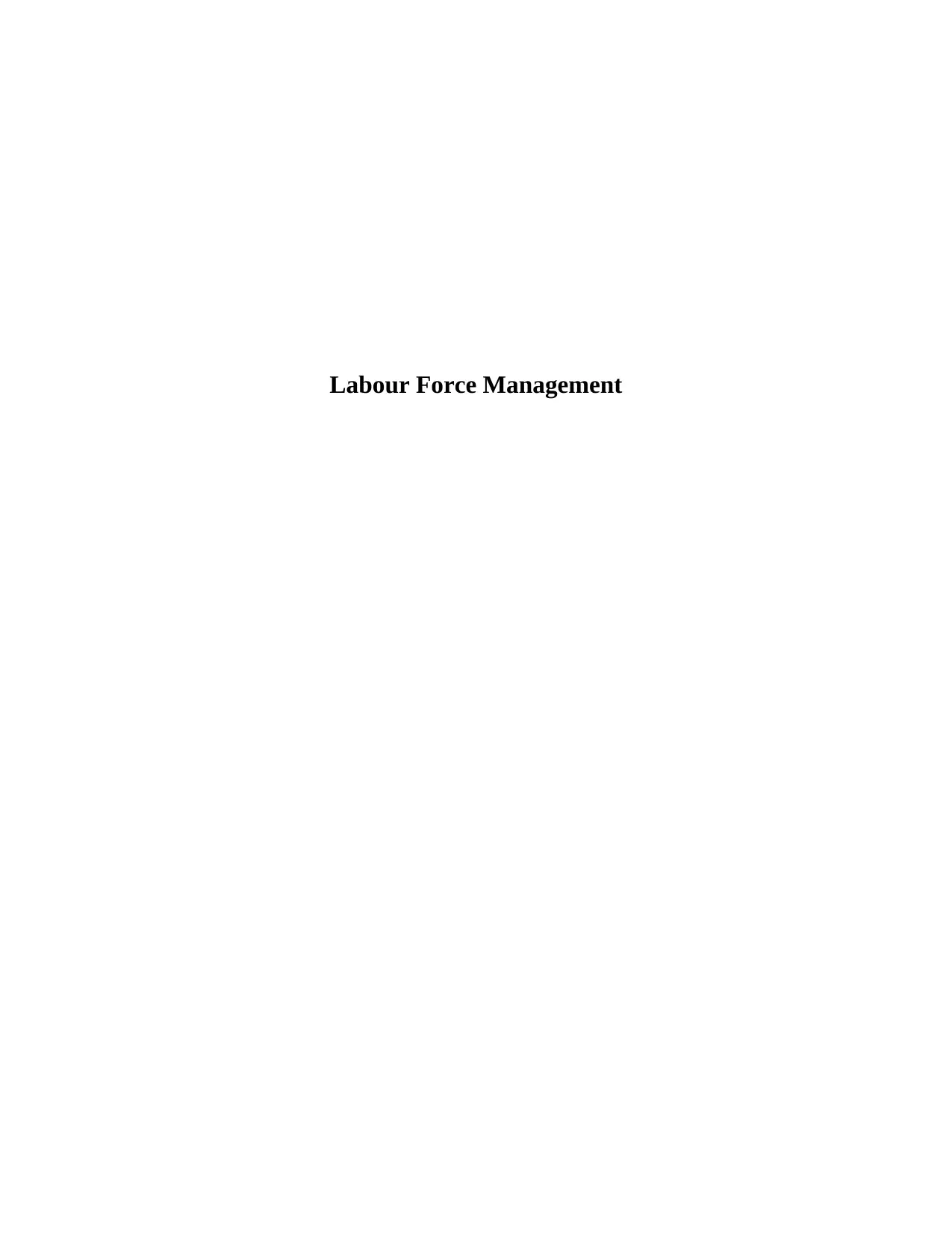
Labour Force Management
Secure Best Marks with AI Grader
Need help grading? Try our AI Grader for instant feedback on your assignments.
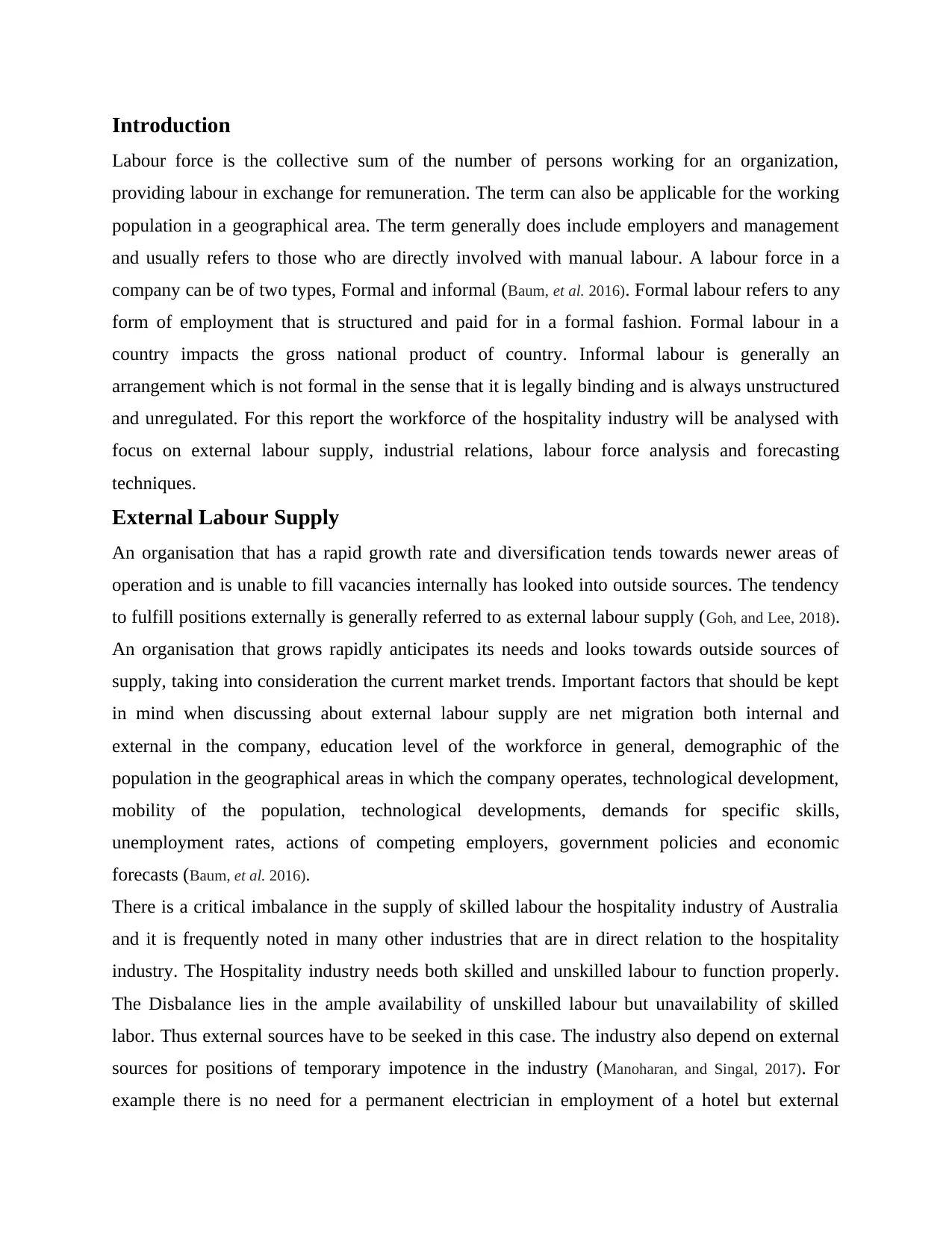
Introduction
Labour force is the collective sum of the number of persons working for an organization,
providing labour in exchange for remuneration. The term can also be applicable for the working
population in a geographical area. The term generally does include employers and management
and usually refers to those who are directly involved with manual labour. A labour force in a
company can be of two types, Formal and informal (Baum, et al. 2016). Formal labour refers to any
form of employment that is structured and paid for in a formal fashion. Formal labour in a
country impacts the gross national product of country. Informal labour is generally an
arrangement which is not formal in the sense that it is legally binding and is always unstructured
and unregulated. For this report the workforce of the hospitality industry will be analysed with
focus on external labour supply, industrial relations, labour force analysis and forecasting
techniques.
External Labour Supply
An organisation that has a rapid growth rate and diversification tends towards newer areas of
operation and is unable to fill vacancies internally has looked into outside sources. The tendency
to fulfill positions externally is generally referred to as external labour supply (Goh, and Lee, 2018).
An organisation that grows rapidly anticipates its needs and looks towards outside sources of
supply, taking into consideration the current market trends. Important factors that should be kept
in mind when discussing about external labour supply are net migration both internal and
external in the company, education level of the workforce in general, demographic of the
population in the geographical areas in which the company operates, technological development,
mobility of the population, technological developments, demands for specific skills,
unemployment rates, actions of competing employers, government policies and economic
forecasts (Baum, et al. 2016).
There is a critical imbalance in the supply of skilled labour the hospitality industry of Australia
and it is frequently noted in many other industries that are in direct relation to the hospitality
industry. The Hospitality industry needs both skilled and unskilled labour to function properly.
The Disbalance lies in the ample availability of unskilled labour but unavailability of skilled
labor. Thus external sources have to be seeked in this case. The industry also depend on external
sources for positions of temporary impotence in the industry (Manoharan, and Singal, 2017). For
example there is no need for a permanent electrician in employment of a hotel but external
Labour force is the collective sum of the number of persons working for an organization,
providing labour in exchange for remuneration. The term can also be applicable for the working
population in a geographical area. The term generally does include employers and management
and usually refers to those who are directly involved with manual labour. A labour force in a
company can be of two types, Formal and informal (Baum, et al. 2016). Formal labour refers to any
form of employment that is structured and paid for in a formal fashion. Formal labour in a
country impacts the gross national product of country. Informal labour is generally an
arrangement which is not formal in the sense that it is legally binding and is always unstructured
and unregulated. For this report the workforce of the hospitality industry will be analysed with
focus on external labour supply, industrial relations, labour force analysis and forecasting
techniques.
External Labour Supply
An organisation that has a rapid growth rate and diversification tends towards newer areas of
operation and is unable to fill vacancies internally has looked into outside sources. The tendency
to fulfill positions externally is generally referred to as external labour supply (Goh, and Lee, 2018).
An organisation that grows rapidly anticipates its needs and looks towards outside sources of
supply, taking into consideration the current market trends. Important factors that should be kept
in mind when discussing about external labour supply are net migration both internal and
external in the company, education level of the workforce in general, demographic of the
population in the geographical areas in which the company operates, technological development,
mobility of the population, technological developments, demands for specific skills,
unemployment rates, actions of competing employers, government policies and economic
forecasts (Baum, et al. 2016).
There is a critical imbalance in the supply of skilled labour the hospitality industry of Australia
and it is frequently noted in many other industries that are in direct relation to the hospitality
industry. The Hospitality industry needs both skilled and unskilled labour to function properly.
The Disbalance lies in the ample availability of unskilled labour but unavailability of skilled
labor. Thus external sources have to be seeked in this case. The industry also depend on external
sources for positions of temporary impotence in the industry (Manoharan, and Singal, 2017). For
example there is no need for a permanent electrician in employment of a hotel but external
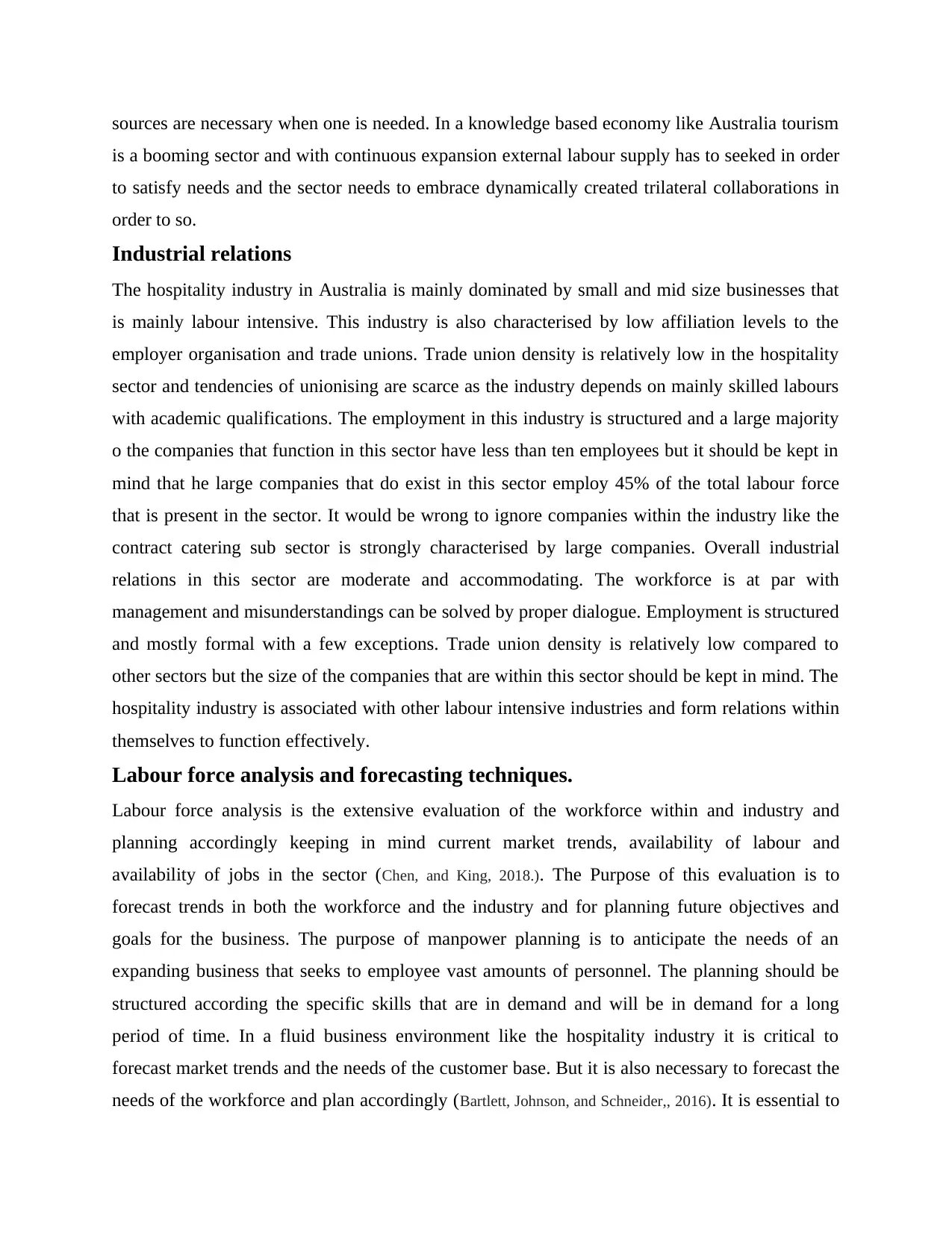
sources are necessary when one is needed. In a knowledge based economy like Australia tourism
is a booming sector and with continuous expansion external labour supply has to seeked in order
to satisfy needs and the sector needs to embrace dynamically created trilateral collaborations in
order to so.
Industrial relations
The hospitality industry in Australia is mainly dominated by small and mid size businesses that
is mainly labour intensive. This industry is also characterised by low affiliation levels to the
employer organisation and trade unions. Trade union density is relatively low in the hospitality
sector and tendencies of unionising are scarce as the industry depends on mainly skilled labours
with academic qualifications. The employment in this industry is structured and a large majority
o the companies that function in this sector have less than ten employees but it should be kept in
mind that he large companies that do exist in this sector employ 45% of the total labour force
that is present in the sector. It would be wrong to ignore companies within the industry like the
contract catering sub sector is strongly characterised by large companies. Overall industrial
relations in this sector are moderate and accommodating. The workforce is at par with
management and misunderstandings can be solved by proper dialogue. Employment is structured
and mostly formal with a few exceptions. Trade union density is relatively low compared to
other sectors but the size of the companies that are within this sector should be kept in mind. The
hospitality industry is associated with other labour intensive industries and form relations within
themselves to function effectively.
Labour force analysis and forecasting techniques.
Labour force analysis is the extensive evaluation of the workforce within and industry and
planning accordingly keeping in mind current market trends, availability of labour and
availability of jobs in the sector (Chen, and King, 2018.). The Purpose of this evaluation is to
forecast trends in both the workforce and the industry and for planning future objectives and
goals for the business. The purpose of manpower planning is to anticipate the needs of an
expanding business that seeks to employee vast amounts of personnel. The planning should be
structured according the specific skills that are in demand and will be in demand for a long
period of time. In a fluid business environment like the hospitality industry it is critical to
forecast market trends and the needs of the customer base. But it is also necessary to forecast the
needs of the workforce and plan accordingly (Bartlett, Johnson, and Schneider,, 2016). It is essential to
is a booming sector and with continuous expansion external labour supply has to seeked in order
to satisfy needs and the sector needs to embrace dynamically created trilateral collaborations in
order to so.
Industrial relations
The hospitality industry in Australia is mainly dominated by small and mid size businesses that
is mainly labour intensive. This industry is also characterised by low affiliation levels to the
employer organisation and trade unions. Trade union density is relatively low in the hospitality
sector and tendencies of unionising are scarce as the industry depends on mainly skilled labours
with academic qualifications. The employment in this industry is structured and a large majority
o the companies that function in this sector have less than ten employees but it should be kept in
mind that he large companies that do exist in this sector employ 45% of the total labour force
that is present in the sector. It would be wrong to ignore companies within the industry like the
contract catering sub sector is strongly characterised by large companies. Overall industrial
relations in this sector are moderate and accommodating. The workforce is at par with
management and misunderstandings can be solved by proper dialogue. Employment is structured
and mostly formal with a few exceptions. Trade union density is relatively low compared to
other sectors but the size of the companies that are within this sector should be kept in mind. The
hospitality industry is associated with other labour intensive industries and form relations within
themselves to function effectively.
Labour force analysis and forecasting techniques.
Labour force analysis is the extensive evaluation of the workforce within and industry and
planning accordingly keeping in mind current market trends, availability of labour and
availability of jobs in the sector (Chen, and King, 2018.). The Purpose of this evaluation is to
forecast trends in both the workforce and the industry and for planning future objectives and
goals for the business. The purpose of manpower planning is to anticipate the needs of an
expanding business that seeks to employee vast amounts of personnel. The planning should be
structured according the specific skills that are in demand and will be in demand for a long
period of time. In a fluid business environment like the hospitality industry it is critical to
forecast market trends and the needs of the customer base. But it is also necessary to forecast the
needs of the workforce and plan accordingly (Bartlett, Johnson, and Schneider,, 2016). It is essential to
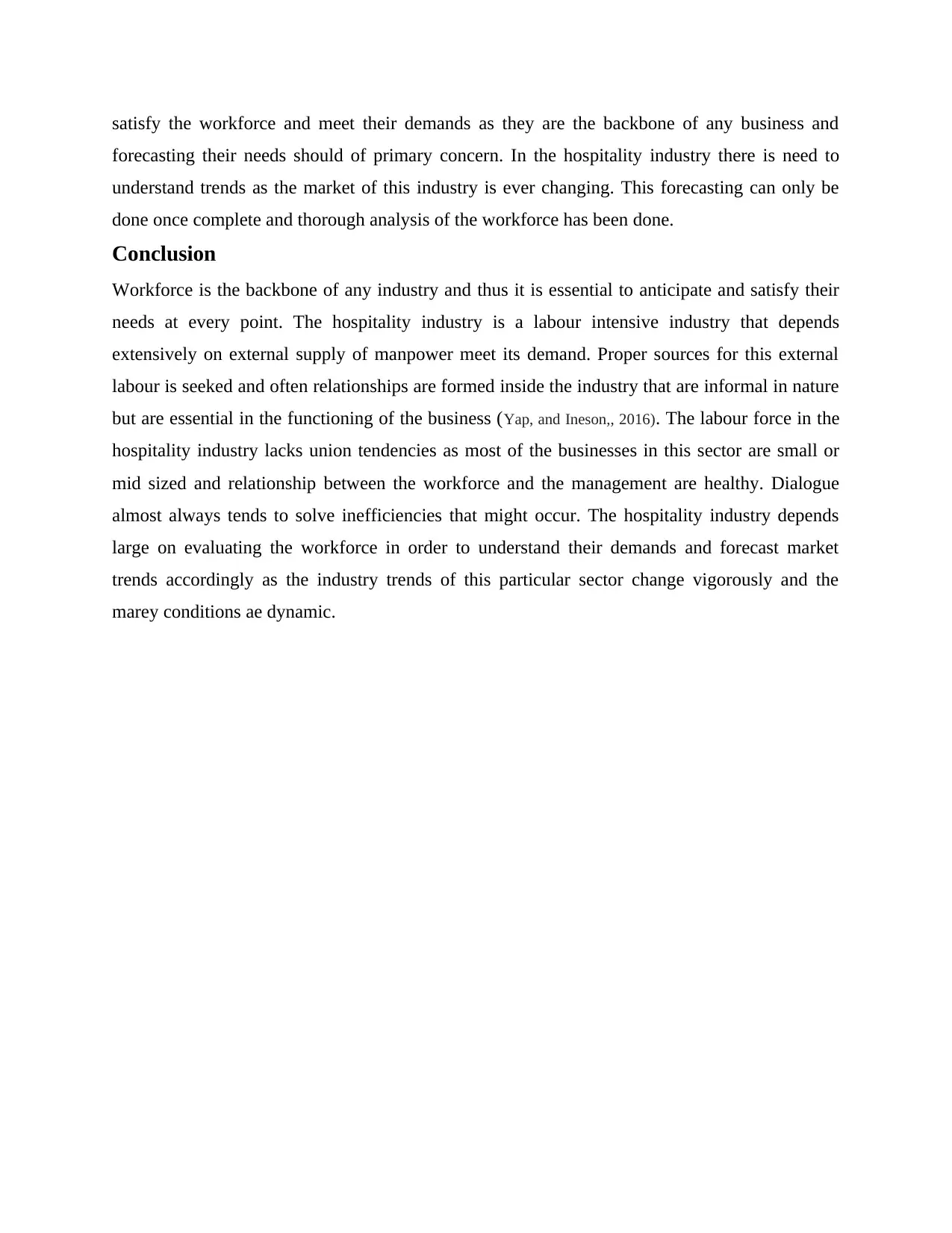
satisfy the workforce and meet their demands as they are the backbone of any business and
forecasting their needs should of primary concern. In the hospitality industry there is need to
understand trends as the market of this industry is ever changing. This forecasting can only be
done once complete and thorough analysis of the workforce has been done.
Conclusion
Workforce is the backbone of any industry and thus it is essential to anticipate and satisfy their
needs at every point. The hospitality industry is a labour intensive industry that depends
extensively on external supply of manpower meet its demand. Proper sources for this external
labour is seeked and often relationships are formed inside the industry that are informal in nature
but are essential in the functioning of the business (Yap, and Ineson,, 2016). The labour force in the
hospitality industry lacks union tendencies as most of the businesses in this sector are small or
mid sized and relationship between the workforce and the management are healthy. Dialogue
almost always tends to solve inefficiencies that might occur. The hospitality industry depends
large on evaluating the workforce in order to understand their demands and forecast market
trends accordingly as the industry trends of this particular sector change vigorously and the
marey conditions ae dynamic.
forecasting their needs should of primary concern. In the hospitality industry there is need to
understand trends as the market of this industry is ever changing. This forecasting can only be
done once complete and thorough analysis of the workforce has been done.
Conclusion
Workforce is the backbone of any industry and thus it is essential to anticipate and satisfy their
needs at every point. The hospitality industry is a labour intensive industry that depends
extensively on external supply of manpower meet its demand. Proper sources for this external
labour is seeked and often relationships are formed inside the industry that are informal in nature
but are essential in the functioning of the business (Yap, and Ineson,, 2016). The labour force in the
hospitality industry lacks union tendencies as most of the businesses in this sector are small or
mid sized and relationship between the workforce and the management are healthy. Dialogue
almost always tends to solve inefficiencies that might occur. The hospitality industry depends
large on evaluating the workforce in order to understand their demands and forecast market
trends accordingly as the industry trends of this particular sector change vigorously and the
marey conditions ae dynamic.
Secure Best Marks with AI Grader
Need help grading? Try our AI Grader for instant feedback on your assignments.
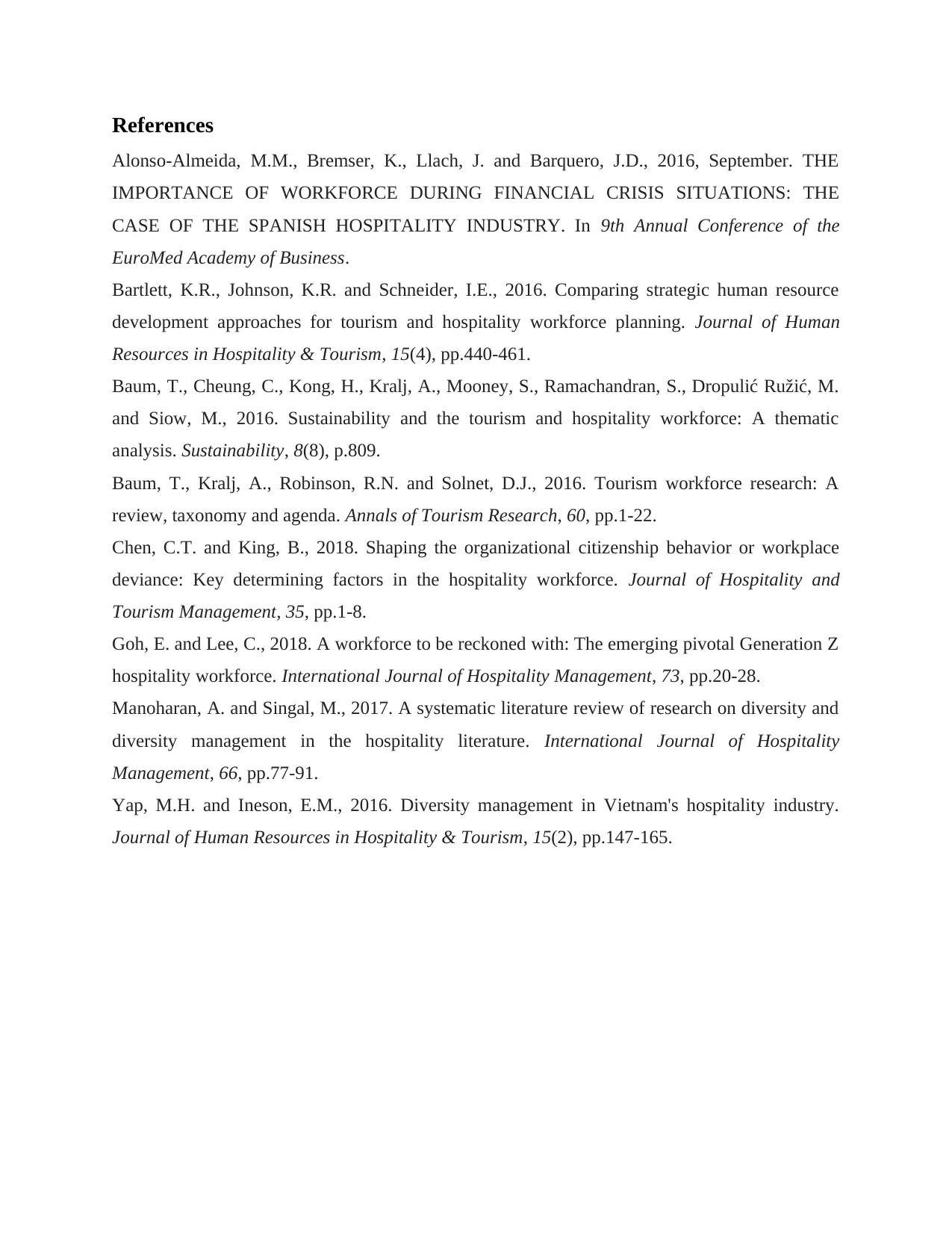
References
Alonso-Almeida, M.M., Bremser, K., Llach, J. and Barquero, J.D., 2016, September. THE
IMPORTANCE OF WORKFORCE DURING FINANCIAL CRISIS SITUATIONS: THE
CASE OF THE SPANISH HOSPITALITY INDUSTRY. In 9th Annual Conference of the
EuroMed Academy of Business.
Bartlett, K.R., Johnson, K.R. and Schneider, I.E., 2016. Comparing strategic human resource
development approaches for tourism and hospitality workforce planning. Journal of Human
Resources in Hospitality & Tourism, 15(4), pp.440-461.
Baum, T., Cheung, C., Kong, H., Kralj, A., Mooney, S., Ramachandran, S., Dropulić Ružić, M.
and Siow, M., 2016. Sustainability and the tourism and hospitality workforce: A thematic
analysis. Sustainability, 8(8), p.809.
Baum, T., Kralj, A., Robinson, R.N. and Solnet, D.J., 2016. Tourism workforce research: A
review, taxonomy and agenda. Annals of Tourism Research, 60, pp.1-22.
Chen, C.T. and King, B., 2018. Shaping the organizational citizenship behavior or workplace
deviance: Key determining factors in the hospitality workforce. Journal of Hospitality and
Tourism Management, 35, pp.1-8.
Goh, E. and Lee, C., 2018. A workforce to be reckoned with: The emerging pivotal Generation Z
hospitality workforce. International Journal of Hospitality Management, 73, pp.20-28.
Manoharan, A. and Singal, M., 2017. A systematic literature review of research on diversity and
diversity management in the hospitality literature. International Journal of Hospitality
Management, 66, pp.77-91.
Yap, M.H. and Ineson, E.M., 2016. Diversity management in Vietnam's hospitality industry.
Journal of Human Resources in Hospitality & Tourism, 15(2), pp.147-165.
Alonso-Almeida, M.M., Bremser, K., Llach, J. and Barquero, J.D., 2016, September. THE
IMPORTANCE OF WORKFORCE DURING FINANCIAL CRISIS SITUATIONS: THE
CASE OF THE SPANISH HOSPITALITY INDUSTRY. In 9th Annual Conference of the
EuroMed Academy of Business.
Bartlett, K.R., Johnson, K.R. and Schneider, I.E., 2016. Comparing strategic human resource
development approaches for tourism and hospitality workforce planning. Journal of Human
Resources in Hospitality & Tourism, 15(4), pp.440-461.
Baum, T., Cheung, C., Kong, H., Kralj, A., Mooney, S., Ramachandran, S., Dropulić Ružić, M.
and Siow, M., 2016. Sustainability and the tourism and hospitality workforce: A thematic
analysis. Sustainability, 8(8), p.809.
Baum, T., Kralj, A., Robinson, R.N. and Solnet, D.J., 2016. Tourism workforce research: A
review, taxonomy and agenda. Annals of Tourism Research, 60, pp.1-22.
Chen, C.T. and King, B., 2018. Shaping the organizational citizenship behavior or workplace
deviance: Key determining factors in the hospitality workforce. Journal of Hospitality and
Tourism Management, 35, pp.1-8.
Goh, E. and Lee, C., 2018. A workforce to be reckoned with: The emerging pivotal Generation Z
hospitality workforce. International Journal of Hospitality Management, 73, pp.20-28.
Manoharan, A. and Singal, M., 2017. A systematic literature review of research on diversity and
diversity management in the hospitality literature. International Journal of Hospitality
Management, 66, pp.77-91.
Yap, M.H. and Ineson, E.M., 2016. Diversity management in Vietnam's hospitality industry.
Journal of Human Resources in Hospitality & Tourism, 15(2), pp.147-165.
1 out of 5
Related Documents
Your All-in-One AI-Powered Toolkit for Academic Success.
+13062052269
info@desklib.com
Available 24*7 on WhatsApp / Email
![[object Object]](/_next/static/media/star-bottom.7253800d.svg)
Unlock your academic potential
© 2024 | Zucol Services PVT LTD | All rights reserved.





